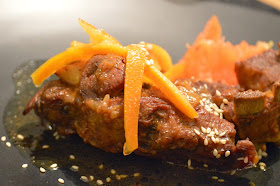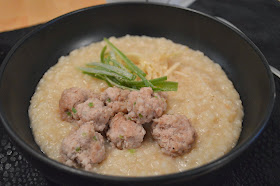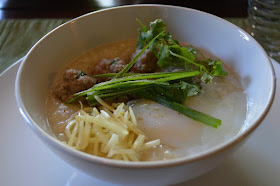12/10/12: Not too long ago, when I was just getting started with this whole blog thing, I was still posting some recipes that, to most of us, would appear sane. This included a recipe for 'fast pho', cutting out the longer steps of pho creation so that it could be made in about 45 minutes. But sometimes you have to throw hours at a dish, just to know what it could be if you didn't get lazy. This recipe is that result. Real, no kidding pho, just like what you can get for a few bucks at most Vietnamese restaurants. Why would I do this at home, you ask? Because I am, as they say in Vietnam, off my nut.
Update 3/18/14: it's been 15 months since I posted this, and I've now made this dish 3 times with increasing success. This time we discovered the convenience of buying the pre-sliced beef from the Asian grocery store, along with the correct pho rice noodles for the first time, which come vacuum-sealed in the refrigerated section, and are ready to go as soon as you dunk them in the hot broth for 5-10 seconds. Saved tons of time in the serving stage, and the only real effort was in the stock making, which has become a fairly painless process that we did while we had company over. So maybe you don't have to be crazy to do this after all.
If I had no job and no other hobbies, I would stay in and make things like this all the time. Unfortunately, like many of us I don't often have time to sit around for 6 hours and cook this dish. Which is too bad, because this pho is as good as any restaurant's, and I know exactly what went into mine. Fresh ingredients, very little salt, lean meat, and a mix of exotic and common spices and sauces.
I want you to make this recipe. I really do. And post on here about your experience. Tell me what you changed, what you used. I'll try to make it easy for you to follow, but it's still a long process that requires some special equipment and ingredients. Most likely, you'll need an Asian grocery store nearby to even entertain this idea. Here's what else you'll need, in decreasing order of cost:
- A meat slicer, a really sharp knife, a friendly butcher, or a decent Asian grocery store
- A large (3+ gallon) pot
- A second large (2+ gallon) pot
- A large colander or strainer
- A fine mesh strainer spoon or skimmer
- Cheesecloth
My recipe is adapted from a collection of different recipes I found online, complemented by techniques from my earlier fast pho recipe, and adjusted based on taste testing during cooking. If you don't like it, reply and tell me why not. I'm probably going to make it again, on a day when it's cold and rainy and I'm trapped in the house, much like this adventure.
Beef Pho (Pho Bo) Vietnamese Noodle Soup
Inspired by Viet World Kitchen, cobbled together by me
The stock:
- 3 medium yellow onions (about 1 pound total)
- 4-inch piece ginger (about 4 ounces)
- 5-6 pounds beef bones (marrow, knuckle, calf's foot) - look for some variety, and bits with tendons that will break down, as opposed to just bone
- One 8" daikon, peeled, cut into 5 large chunks
- 15 star anise
- 8 whole cloves
- 3-inch cinnamon stick
- 1 tsp whole black peppercorns
- 3 tbsp salt
- 6 tbsp fish sauce
- 2 tbsp sugar, or 1 ounce yellow rock sugar (duong phen)
The dish:
- 1.5-2 pounds small (1/8-inch wide) dried or fresh banh pho (rice stick) noodles
- 1/2 pound raw eye of round, brisket, sirloin, or other tender, lean beef, sliced very thinly across the grain
- Thai basil (hung que)
- Cilantro
- Bean sprouts (about 1/2 pound)
- 1 jalapeno, thinly sliced
- Lime wedges
- Hoisin sauce
- Sriracha sauce
 |
| The setup. Are you kidding me, look at all of the bones! |
Char onion and ginger. Cut your onions in half, peel off the papery outer layer, and set over an open flame with the unpeeled ginger on a grill or gas stove. I repurposed the rack from my oven and placed over the gas burners to make a large cooking surface. Let the skin burn, rotating occasionally. After about 15 minutes, they will soften and become fragrant. Let cool, and rub off the blackened parts off the onions under running water. Peel the ginger. Set aside.
 |
| Char the root vegetables over an open fire |
 |
| After you char the vegetables, rub off some of the blackened char and throw this into the stock |
Parboil the bones to clean off 'impurities'. This was a commonly encountered step online, so I didn't skip it. Place bones in large stockpot (minimum 12-quart capacity) and barely cover with cold water. Boil vigorously over high heat for 2 to 3 minutes. Now dump the bones into a colander and rinse with warm water. Scrub out your pot and return bones to the pot.
 |
| Rinse dem bones! |
Now make your soup base. Make a small herb pouch by placing the cinnamon, cloves, peppercorns, and anise in cheesecloth and tying into a pouch - this will prevent excess grit from accumulating in the soup. Toast your spices in a dry saute pan before putting them into the soup, which really brings out their flavor. Put the bones, the herb pouch, the onions, and ginger in the stockpot, and add 6 quarts of water. Bring to a boil over high heat, then lower flame to a simmer (not a boil).
 |
| Toast your spices in a dry pan to bring out extra flavor |
 |
| You know you want a pouch like mine. |
For the next hour or so, use a skimmer every 10 minutes to remove any scum that rises to surface. What happens if you don't skim this? You get all kinds of weird protein foam that bubbles up, called "colloidal juice". And since this looks about as appetizing as it sounds, you probably don't want this in your soup, because if you leave it it will dissolve back into the stock, making it cloudy. It's also got some of the fat and impurities in it according to the CIA, so it pays to grab it and get it out of there. But the jury is out on whether that last part is true or not. Anyway, here's what I'm talking about:
 |
| Got a skimmer? If not, consider investing in one if you make stock. |
 |
| Every 10 minutes or so, get that foam out of there. It will go from this... |
 |
| ...to this. Much better, isn't it? Trust me, it will pay off big time by being clear and delicious |
Skim and continue simmering for a total of 90 minutes, then add the daikon and continue cooking for another few hours. How long? Until you're tired of cooking it, that's how long. I would say a minimum of 3 hours, and a maximum of 5 (total, not from this point). While cooking, taste periodically and adjust seasonings thusly - if it's too bland, add more salt, 1/2 tbsp at a time. If it's not tart enough, add more fish sauce, 1 tbsp at a time. If it's too tart, add more sugar, 1 tsp at a time. You want it a bit concentrated, because you'll be adding unseasoned ingredients to the final product, like noodles and sprouts. Don't worry if it tastes a little salty, this will cancel out the fact that you're adding a ton of unseasoned beef and noodles at the end. When you're comfortable with the finished product, pour out the broth through a colander into a medium (2 gallon) stockpot to remove the large solids, then pour back to your large pot and, in the process, strain through a strainer lined with cheesecloth.
If you're impatient, go ahead and continue to the next step. Go on, do it. I won't judge you. But if you can afford to wait a day, you can let the soup base cool down, and have all of the fat rise up to the top for you to scrape off and discard. If you did things right, this broth will have enough gelatin to choke a horse, and will look like it should be served in a small glass bowl at the hospital. It would probably make the patients feel better, I tell you what.
 |
| This is the soup, cooled down with fat removed. It is not moving at all in this picture. |
When ready, assemble pho bowls. This is where you can screw up and get yourself in trouble. What happens next is a bit of cooking (and thermodynamics) magic, wherein raw meat is instantly cooked by pouring scalding hot broth all over it. So you want the meat to be paper-thin, and you need for there to be enough thermal mass between the broth, the noodles, and the bowl to ensure that the meat gets cooked. How much mass? Well, I could get out my heat transfer book and tell you to within a few ounces, or we could just go with "a lot of broth", which is a slightly less scientific but still valid answer.
Slice your raw beef of choice as thin as you can get it. A meat slicer comes in handy. Shoot for something the thinness of deli roast beef. Before slicing, chill the meat for 15-60 minutes: more if you have a real slicer, less if you're going at it by hand like some kind of tissue dissection. Either way, set it aside and let it warm up a bit.
Heat the pho broth to a boil, and prep your noodles. Get two pots going - one with just water for the noodles, one with the broth. Follow the directions on the noodle package, which will basically tell you to soak in hot water for 15 minutes, rinse, and then throw into a pot for a few minutes, until cooked.
 |
| Prep your sprouts and noodles |
Heat up some bowls in the microwave, ensuring they are plenty warm before you start. You really want to get a lot of heat into this, so the meat cooks. Put a serving of noodles into the bowls. Next, throw in bean sprouts, which you can cook for 30 seconds in your noodle water to take out some of the raw flavor, and warm them up. Place in the bowl, or on the garnish plate.
Now add your meat - place the thin strips over the top of the noodles. Pour the boiling broth over and watch the magic... the meat will cook instantly as you pour, turning from red to gray.
 |
| Prep for this really cool process by laying out the raw meat over the cooked noodles. Then just pour on the boiling broth... |
 |
| ...and watch the fun! Want to see it again? |
 |
| Before... |
 |
| ...after. |
Serve your pho with a garnish plate consisting of cilantro, bean sprouts, jalapeno slices, and Thai basil. Also set out hoisin sauce and sriracha (not homemade, sorry) to pour in. Now savor every bit of your hard work, or that of the person you bribed into making this for you.
And with that, I'm tired. I'm going to bed.



























